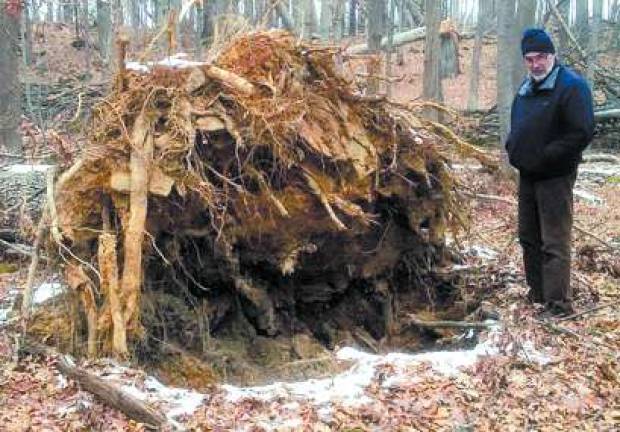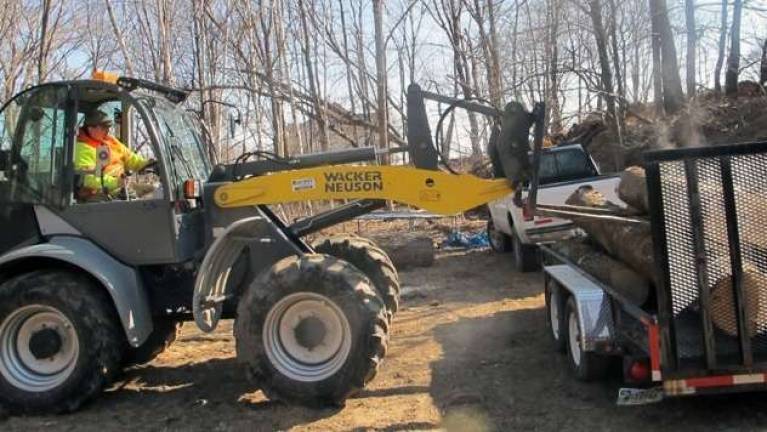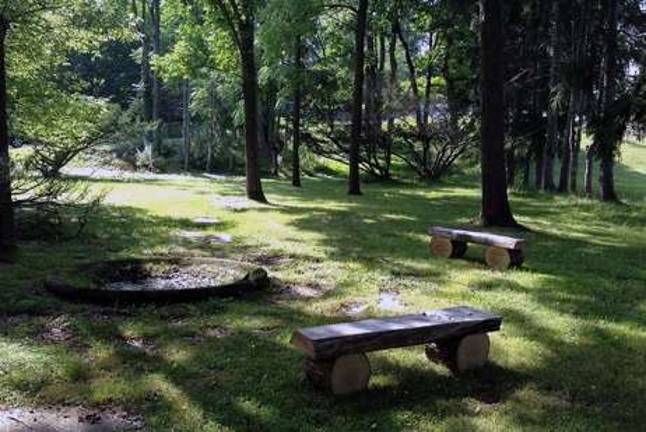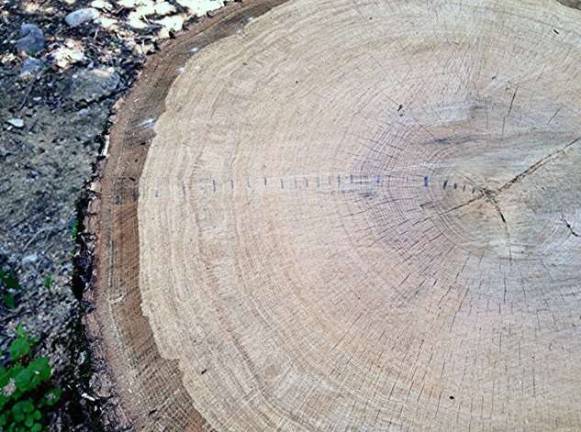Many partners work to restore Lewis Woodlands




Submitted By Geoff Howard
WARWICK — One of the areas hardest hit when Hurricane Sandy roared through Warwick in October 2012 was the Lewis Woodlands, now known officially as the Warwick Village Park. This woodland habitat, laced with walking trails, is one of the village’s true hidden gems.
The Woodlands is a 15-acre parcel between Colonial and Maple avenues, although the official entrance is off of the small, dead-end Robin Brae. Once part of Belair, the Fowler family estate, the acreage was slated for subdivision in the 1950s when Madison and Elizabeth Lewis purchased the property and gifted it to the Orange and Dutchess Garden Club who eventually deeded it over to the village in 2011 for use as a park.
Now a beautiful, tranquil area of mysterious rock formations and large trees, many of which are unusual specimen trees that the Fowlers imported from around the world, the Woodlands today goes largely unnoticed by most Warwickians.
But Sandy certainly noticed and when those high winds roared through from the north, the northeast edge took the brunt of the storm’s fury. In a matter of minutes, hundreds of trees were damaged and roughly 40 large trees toppled with their massive root balls intact and exposed. A dozen of them were more than 200 years old.
The road to recovery
In early December of 2012, Dave Washburn and Geoff Howard of Sustainable Warwick visited the site to assess the damage. Drawing on his extensive background in sustainable forestry, Washburn came up with a plan to bring the Woodlands back.
The first step was to contact Michael Newhard who, in addition to being the village mayor, is a life-long village resident with many memories of the Woodlands from the “old days.”
Organizing the necessary resources — money and people — to bring the Woodlands back was a long and challenging process. The village applied for FEMA Sandy-relief funds and eventually — it took more than a year — $9,000 came through, but only to mitigate “safety issues,” downed or dangerously leaning trees within a few yards of the trail network.
Still, that was a start and in January 2014, Acorn Tree Service was ready to go. But Mother Nature didn’t make it easy.
As the snows of January and February lingered into March, Acorn was forced to sit idle during the prime months when the ground was frozen and their heavy machinery could get into the Woodlands without doing major damage. And when the snows began to melt into mud, it looked as if an entire year might be lost.
Finally, however, the Woodlands caught a break. Just as the snow finally melted, a cold snap froze the ground solid and Acorn went in. The trees across the trails and the dangerous leaners were cut up and dragged out. What had been a beautiful wooded section pre-Sandy, and a devastated “war zone” post-Sandy, was transformed into semi-cleared woodland “in recovery.”
In addition to a lucky break with the weather, the recovery was greatly aided when homeowner Chris Smith, whose Colonial Avenue property backs onto the hardest hit area of the Woodlands, allowed Acorn’s heavy equipment to access the Woodlands and to temporarily park the pulled out logs on his land.
Unusual coalition continues the recovery
When Acorn left, however, the job was far from finished. That is when an unusual coalition of local forces banded together to continue the recovery process.
The village’s Department of Public Works, with many skilled foresters among them, did some of the heaviest work: Downing and hauling trees beyond the limit of Acorn’s assignment, stacking cut logs and clearing the massive piles of brush.
Then came New York Heartwoods (NYH), a local company with an unusual mission: To take millable trees that are downed, diseased, dying, dangerous or dead and mill then into usable local hardwood lumber.
NYH’s two principals on this project, Megan Offner and Washburn, had the idea that a portion of this Sandy-salvaged wood could be returned to the village for use in a variety of civic projects.
That is already starting to happen.
Working closely with both the DPW and NYH, Sustainable Warwick — the local community organization that is responsible for, among other projects, the Community Garden and Orchard — organized a “Woodlands Brigade” of volunteers to continue the effort. Brush was removed, paths cleared, and the Woodlands clearly on the road back.
Beyond recovery
Sometimes when a community amenity sustains a body blow as the Lewis Woodlands did with Sandy, there is a local determination that springs up to not only repair the damage but make things even better than they had been. And that’s precisely what’s happening here.
In the months since the initial clean-up, several things have happened — and more are in the works. NYH has taken some of the downed trees and turned them into a series of benches that are perfect for the Robin Brae entrance to the Woodlands.
Further enhancing that entrance, there will soon be a butterfly/pollinator garden that is being sponsored by the Warwick Valley Gardeners, and particularly their Youth Gardeners program. In addition, some of the preparation work may be done by the Future Farmers of America students at Warwick Valley High School.
Another thought from the group is to turn the once-devastated area into a “learning lab” on woodland life cycles and regeneration. For example, Dave Washburn's son, a professional forester, has chemically enhanced the rings on the remaining stump of a 222-year-old white oak and marked them in 10-year intervals going back to the early days of this country. The plan is to put actual year markers on the tree stump, have tags indicating important moments in Warwick and American history, and create a walk-around viewing platform that would let people see the tree’s story up close.
And there even more plans: Rebuilding the bridge across the creek at the Woodland’s entrance using milled planks from Sandy-downed trees; Art in the Woodlands featuring temporary exhibits of outdoor sculpture; and small-scale musical or dramatic performances in the glade at the Woodlands’ entrance.
Many ideas, many possibilities.
The story of Superstorm Sandy and the Lewis Woodlands is one of loss and recovery and, with a coalition of local government, local companies, local community organizations, and local folks working together, it is looking like a wonderful local success story.
Geoff Howard is chair of Sustainable Warwick.